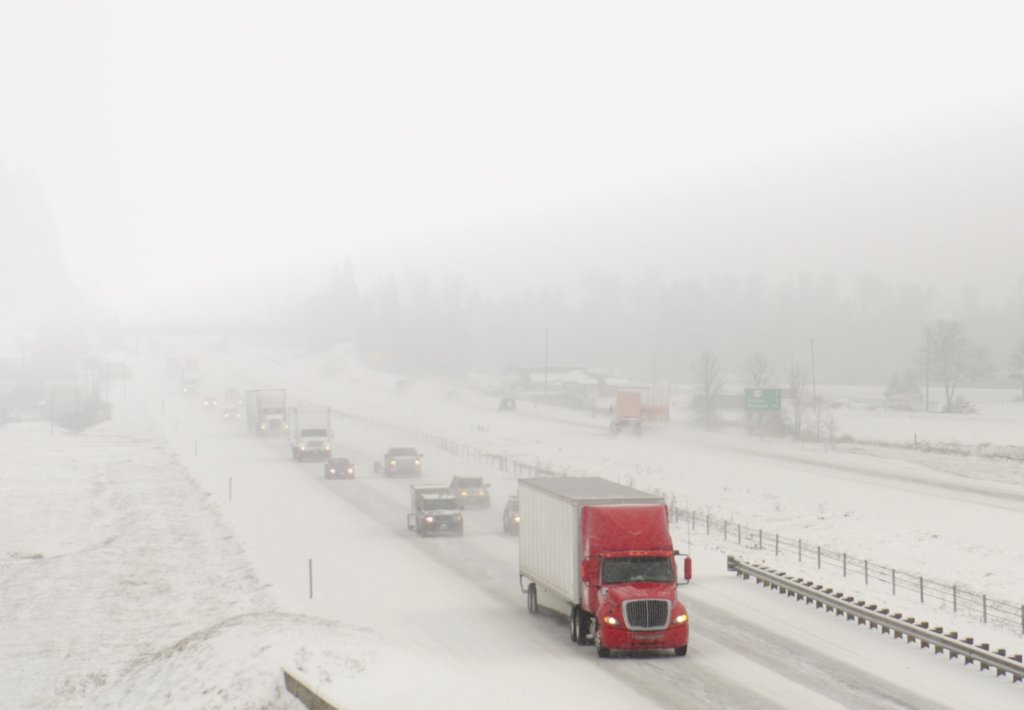Safety Tips Every Truck Driver Should Follow

You probably learned a lot of truck driver safety tips while you were going through training. Yet with so much to learn, it’s only natural to forget some of your training once you get on the road. Safety is just as important on your 1,000th trip as on your first, so here is a refresher on some of the key safety tips for truck drivers.
Truck driving safety topics fall into three general categories based on the three stages of any haul: pre-trip, on the road, and post-trip. We will also review some general winter driving safety tips for truck drivers.
Pre-Trip: Safety Driving Tips For Truckers
Truck driver safety begins before you ever set foot inside your truck. When it comes to trucking, pre-planning is key to making sure your trip is both productive and safe on the road.
Plan your route.
Whether you’re driving a single load from Point A to Point B or dropping off smaller loads along the way, it’s essential to plan your route. This not only helps ensure an efficient trip and keeps you compliant with driving hours and other regulations, but it can also boost the safety of your trip. You won’t be distracted by trying to figure out where to go, and you won’t risk encountering low bridges or other hazards.
Truckstop offers two features to help with route planning. Multi-trip lets you plan trips with multiple stops, while Fuel Desk helps you pick out the best fuel stops along the way.
Develop a preventative maintenance plan.
If you’re an owner-operator, you will be responsible for designing your own preventative maintenance plan. If you drive for a company, your carrier should develop the schedule. But either way, you know your own truck, so don’t be afraid to weigh in. This plan should be based on things like mileage, days on the road, and any previous history of breakdowns.
Perform a pre-trip inspection.
The Department of Transportation (DOT) requires truck drivers to perform a detailed pre-trip inspection. The more thorough you are in checking everything from the lights to the brakes to the coupling system, the safer you will be on the road. Be sure to carry an emergency kit with the tools and spare parts you need to perform minor repairs during your trip.
Check weather and traffic reports.
Before you set out, take a look at the latest weather and traffic reports along your route, and adjust your plan accordingly. It’s also a smart idea to use an app that will update you if things suddenly change en route.
Follow safe loading procedures.
The step-by-step procedures you follow will vary according to the type of equipment you drive and the specific load you are hauling. In general, be sure to apply the tractor and trailer parking brakes, ensure that all items are properly strapped down, follow all instructions the shipper gives you, and double-check that you have a clear path and the dock plate is removed before pulling out.
On the Road: Safety Driving Tips For Truckers
Of course, most of the safety risks truckers face are on the road. Fortunately, there are several things you can do to reduce your risks of a serious incident during your trip.
Wear a seatbelt.
Though decades of research continue to show that seatbelts save lives, a stunning one in six truck drivers doesn’t regularly wear one. Regular seatbelt use is one of the easiest ways to improve your safety.
Check blind spots.
All trucks have blind spots, and it’s up to you to know where they are and make sure they are clear before changing lanes. Carefully set your mirrors to improve your view, and follow the ten-second rule for lane changes: put on your blinker for three full seconds before changing lanes, and take seven seconds to complete the change. Only make lane changes that are needed.
Monitor speed limits.
It’s incredibly easy to let your speed creep up as you drive, especially if you are on a tight schedule. But speed limits often change with little warning, and the faster you are going the more difficult it will be to stop in an emergency. Frequently check the current speed limit as well as your speed.
Lower speed on curves.

Even the posted speed limit can be unsafe when navigating a big truck with its high center of gravity on a curve. Slow to at least 5 mph below the speed limit or even lower on steep curves.
Avoid cell phone use while driving.
Not only is using a cell phone while driving dangerous, but it’s also restricted by the Federal Motor Carrier Safety Administration (FMCSA). You’re not allowed to reach for your phone in a way that takes you out of a normal driving position, to push more than a single button, or to hold your phone in your hand. Though hands-free calling is permitted, it’s a much better safety practice to make calls or check your texts and emails only during a rest break.
Follow the seven-second rule.
For regular passenger vehicles, leaving three seconds of distance between you and the car ahead of you is fine. But trucks are far bigger and heavier, with a much greater stopping distance. Increase this to seven seconds of distance on clear, dry roads. In wet or wintery conditions, heavy traffic, construction zones, or other dangerous areas, leave an even bigger distance cushion.
Avoid drugs and alcohol.
This should go without saying, but it’s always worth a reminder. Driving under the influence is illegal as well as dangerous. Commercial drivers may not have any measurable alcohol in their bloodstream or consume any alcohol within four hours before taking control of their vehicle.
Stay cool, calm, and collected.
Road rage can lead to dangerous driving behaviors and dramatically increase your risk of causing accidents. If someone angers you on the road, take a deep breath and slow down (but don’t slam on the brakes). Allow that person the needed space to get away from you and give yourself time to calm down.
Always use signals.
It’s hard enough on other drivers when regular passenger car turn signals aren’t utilized. When you’re driving a large vehicle that is difficult for other drivers to see and maneuver around, it’s essential to signal your intentions for a few seconds before making a turn or a lane change.
Take regular rest breaks.
Hours of service regulations govern how long you can drive at a time and how much rest is required before you drive again. But few truck drivers can safely maintain eight hours in the driver’s seat with no breaks at all without losing focus and driving concentration. One of the best ways to increase safety is to take short breaks every few hours. Get out and take a short walk. Then check on both your equipment and your load before getting back to trucking. Always follow the “three points of contact” rule, ensuring that both hands and one foot are in contact with the truck when getting in or out.
Post-Trip: Safety Driving Tips For Truckers
Truck driver safety doesn’t end when you get to your destination. First, you’ll need to follow these post-trip safety practices.
Inspect delivery spots on foot.
It’s always a smart idea to check out exactly where you will be unloading your truck. Park nearby and walk over to inspect the unloading area. Make sure there’s enough room to safely maneuver, and make a mental note of any obstacles, such as fire hydrants or ditches.
Follow safe unloading procedures.
Be aware that cargo may have shifted during the trip. Carefully open just the right side door a crack, keeping your body close to the left side door. If all looks well, use both hands to open each door, minimizing the impact of wind gusts. Secure the doors open and use safe lifting procedures for each item. Make sure all people and equipment are clear of the truck before pulling away.
Inspect your truck.
At the end of each day or trip, don’t forget the post-trip inspection. You’re required to inspect everything from the tires to the windshield wipers, and complete a written report within 24 hours. When you’re finished, lock up and go get some well-deserved healthy food and some rest.
Winter Weather: Safety Driving Tips For Truck Drivers

Winter weather poses some special safety challenges. Here are a few winter weather safety tips for all truck drivers.
Treat your diesel.
Although it doesn’t exactly freeze, diesel fuel does start to gel at temperatures right around the freezing point of water (32F), and it can become completely unusable at about 17F. Even partially-gelled diesel is hard on your engine, so add an anti-gel additive to the tank when the temperature starts to fall.
Check brake lights.
Make sure your brake lights are working, and keep a close eye on those ahead of you. In poor weather, this may be the only warning you have that traffic is stopped. Slow down and double your following distance. Start braking earlier than you think you need to. Drive smoothly and avoid erratic maneuvers.
Carry emergency supplies.
You never know when conditions could deteriorate, so be prepared. Carry tire chains, a charged cell phone, and an emergency kit. Make sure you have nonperishable food and a few blankets in case you get stuck on the road.
Watch for black ice.
Black ice is a thin layer of ice that forms right around the freezing point, especially on bridges and overpasses. It is nearly impossible to see and can quickly send you into a skid. Suspect black ice whenever you start noticing frost on your windshield. Slow down and be prepared for possible sliding.
Pay attention to tire spray.
If the road conditions looks wet, check the tires of the vehicles around you. If they’re spraying a lot of water, odds are good that the road is just wet and not yet frozen. If you don’t see much spray, the wet-looking patches could be ice. Remember, driving conditions can change quickly.
Practice defensive driving.
Assume that the drivers around you have little experience in winter weather. Drive defensively, ready to evade potentially dangerous situations. Stay cautious and alert, and avoid driving in ruts left by other drivers. Even loose snow can become hard-packed into ice.
Pull over when conditions are dangerous.
Ultimately, no schedule is worth risking your life. If you start seeing trucks spun out along the roadway, or if you feel like the weather conditions are beyond your ability to safely control your truck, get off the road. Pull over at a truck stop if you can safely get to one. Otherwise, simply choose a safe location well off the road and wait it out. You’ll be glad you have your emergency rations! And remember, you can log the time as a rest break, potentially resetting your hours of service (depending on how long you are pulled over).
Safely Haul More High-Paying Loads
With safety procedures in place, it’s time to find more high-paying freight to haul. The Truckstop Carrier Load Board offers everything you need to find new loads and keep your truck rolling. Get a free demo today.

Find out how our platform gives you the visibility you need to get more done.
Get helpful content delivered to your inbox.
Schedule a demo.
Find out how our platform gives you the visibility you need to get more done.





